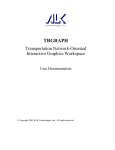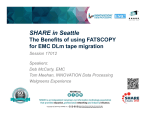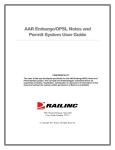Download ALK Flow
Transcript
ALKFLOW Traffic Assignment Workspace User Documentation © Copyright 2003 ALK Technologies, Inc. All rights reserved. Table of Contents Introduction to ALKFLOW ............................................................................................ 1 Loading ALKFLOW................................................................................................... 1 Inputs to ALKFLOW...................................................................................................... 2 The Network ............................................................................................................... 2 AB Pairs ...................................................................................................................... 3 Flowing Traffic ............................................................................................................... 4 FLOWTRAFFIC Tab 1: Main .................................................................................... 4 FLOWTRAFFIC Tab 2: Input Fields ......................................................................... 5 FLOWTRAFFIC Tab 3: Routing................................................................................ 6 FLOWTRAFFIC Tab 4: Output A-Bs........................................................................ 7 Executing FLOWTRAFFIC........................................................................................ 8 Outputs of FLOWTRAFFIC........................................................................................... 9 Miled ABPAIRS ......................................................................................................... 9 Flow File ..................................................................................................................... 9 Total Flow File.......................................................................................................... 10 Bad File..................................................................................................................... 11 ALKFLOW User Manual Page 1 Introduction to ALKFLOW ALKFLOW is one component of the Princeton Transportation Network Model and Graphic Information System (PTNM). ALKFLOW, like TRGRAPH, is a Dyalog APL/WTM workspace. It provides the user with the ability to route traffic data over transportation networks. In other words, ALKFLOW takes traffic volumes and on-line point/off-line point information and determines the set of links over which the traffic would travel based on criteria that the user provides. Output from ALKFLOW includes data on the routes (e.g. distance traveled) and directional volume data on the network links. The process is called “traffic assignment” or “flowing the traffic”. The workspace has been designed primarily for calculation and therefore, has no function to perform graphics. However, the outputs of TRGRAPH are fully compatible with the workspace TRGRAPH and can be displayed easily using the strong graphics capabilities of TRGRAPH. This workspace is geared toward using the railway, highway and waterway networks, as described in TRGRAPH User Documentation. This documentation assumes that the user has some knowledge of APL and TRGRAPH. Loading ALKFLOW The variables and functions that constitute the APL workspace ALKFLOW are stored in a file named ALKFLOW.dws in the default file directory (c:\ptnmw) in the hard disk. They can be loaded to the APL session by typing the following system command from the workspace window. )LOAD ALKFLOW Refer to the TRGRAPH User Documentation for more information on loading workspaces. ALKFLOW User Manual Page 2 Inputs to ALKFLOW The workspace requires a transportation network and a set of traffic volume data termed “AB pairs”. The volume data should be stored on disk files with extension “.abp”. The Network When the workspace is loaded, the user is shown the various available networks in the default “c:\ptnmw” folder and asked to choose one. This feature allows the user to use the workspace with limited knowledge of the structure of the networks. More sophisticated uses of ALKFLOW will require knowledge of network variables and structure. The following are the railway network variables used in ALKFLOW. Variable Name COORD Type Matrix Dimensions (nodes,2) DIST Vector links LINKS Matrix (links,2) MLC Matrix (6,links) OWNER Matrix (n,links) Description Nth row holds (x,y) coordinates for the nth node. Col 1: x-coordinate Col 2: y-coordinate Nth element holds distance for the nth link. Values are miles in integer tenths of miles. Nth row holds node pair for the nth link. Col 1: A-node number Col 2: B-node number Each row holds MLC (mainline code) values for a service type. Nth column holds values for the nth link. Service types and associated row are: 1 – General Merchandise 2 – Intermodal 3 – Coal/Bulk 4 – Auto Racks 5 – Double stack 6 – NS (special codes to support custom software developed for NS) For the n largest railroads, each row holds 1’s (yes) and 0’s (no) indicating whether the railroad operates on the link. See TRANS variable to identify the railroad associated with each row. ALKFLOW User Manual TRANS Vector Page 3 999 Nth element is a pointer to OWNER or SHORTLINE for the nth railroad. Values 1-999 are pointers to the kth row of OWNER. Values 1001+ are pointers to elements of SHORTLINE. (Pointer is value minus 1000). Refer to the user documentation on TRGRAPH for more information on how to create and modify networks. AB Pairs The set of traffic volume data is termed “AB Pairs”. AB pairs usually take the form: RRnum A-node B-node S-Type Vol 1 …. Vol N where: • • • • • RRnum is the AAR railroad number A-node is the on-line point for the railroad B-node is the off-line point for the railroad S-Type is service type, optional input Vol 1, etc., are the volumes of certain kinds of traffic moving from A to B on the railroad, such as cars or tons For example, the AB pair may be: 802 16434 16710 2 250 10000 In this case, the railroad is Union Pacific (802), the on-line point is Chicago (16434), the off-line point is Los Angeles (16710), volume 1 is (250) is the number of boxcars of widgets annually shipped from Chicago to Los Angeles, and volume 2 (10,000) is the net tonnage of the widgets. The service type is 2 suggesting that it is an Intermodal move. AB Pairs can be created in several ways and stored are fixed formatted text files with file extension “.abp”. The text file can be created using a text editor such as NotePad or TextPad, or it could be an output of a ForTran or C program that extracts traffic information from a large dataset. Data extraction and reformatting can also be performed by applications such as Syncsort, MS Access or MS Excel. Alternatively, user-defined functions from TRGRAPH coupled with WRITEFIX can be used to generate the AB Pairs file. For efficient running of the program, sort the AB Pairs file by Railroad, Service Type (if included), A-node and B-node. If all AB pairs are to be routed using the same service type, this field can be excluded in the input and instead, the routing type can be set in the FLOWTRAFFIC Tab 3. ALKFLOW User Manual Page 4 Flowing Traffic The main purpose of the ALKFLOW workspace is to assign traffic volumes to links on a transportation network. The corresponding PTNM function, which allows the user to set the parameters for the traffic assignment process and execute it, is called FLOWTRAFFIC. To invoke this function, type FLOWTRAFFIC from the workspace editor and press ‘Enter’. A user interface called “ALKFLOW Control Panel” appears on screen. This panel has four tabs, each with a set of parameter options to be specified by the user. The following sections describe all the items in the four tabs. FLOWTRAFFIC Tab 1: Main Figure: FLOWTRAFFIC Main Tab The user enters filenames for two input and five output files, including three optional outputs. The items are: • Input Flow Network: PTNM network (*.ntw) • Input ABPAIRS files: Traffic volume data as described in the preceding section of this manual (*.abp) • Output LOG file: Text file (*.log) will contain a log of all the flow parameters, flow summary and errors, if any. ALKFLOW User Manual • • • • Page 5 Output BAD file: Text file (*.bad) will contain a list of nodes from the AB pairs that were not geocoded, clean up information (if clean-up option is set), and their originating and terminating volumes. Output FLOW file: Optional Flow file (*.flo) is APL readable. It will have volume information by link number and carrier for every link with traffic assigned to it. Output TFLOW file: Optional Total Flow file (*.tfl) is APL readable. It will have total link volume information for every link with non-zero volume, aggregated over all carriers using that link. Output miled ABPAIR file: Optional text file (*.mil) will have total distance and impedance appended to each record in the Input ABPAIR file. The filenames can either be typed in the text box provided, or picked using a browsing window by pressing the corresponding “Select” button, located adjacent to the text box. After specifying all the filenames, proceed to the other three tabs. After filling out information on all tabs, come back to the Main tab to execute the traffic assignment. FLOWTRAFFIC Tab 2: Input Fields Figure: FLOWTRAFFIC Input Fields Tab The second tab allows the user to describe the ABPAIRS file. The first item is the Input ABPAIRS file. The name of the ABPAIRS file as selected in the Main tab is shown. Below are two sets of fields: Input Route Fields, namely Carrier, Service Type, A-Node and B-Node, and Input Flow Fields, or up to 15 volume counts. Enter the Starting byte and Length of each field from the ABPAIRS file in the space provided. A few sample ALKFLOW User Manual Page 6 records are read from the file and displayed in the rectangular box at the bottom of the screen, along with a scale to verify field positions. Check the box for ‘Valid Service Type?’ if the file has service type information to be used in selecting routes. The number of records to read per Pass can be altered if the user wishes. FLOWTRAFFIC Tab 3: Routing Figure: FLOWTRAFFIC Routing Tab Routing options can be specified using items on this tab. The first one is the name of the network, as selected in the Main tab can be changed here. The next three items have check boxes and only one of those can be selected to specify the routing formula for traffic assignment. The first option, to use default Service Type Routing for each route based on its service type as specified in the AB Pairs file, is available only if the user selected ‘Valid Service Type’ in the second tab. The second option lets the user pick one of the generic routing formulae: BESTROUTE, ROUTE 2, ROUTE 3… , ROUTE 6 or DISTANCE. Alternatively, a user-defined routing formula (a vector with impedance values for each link) can be selected using the third option. If you want the routing to respect family definitions for carriers and allow reciprocal operating rights for each carrier within a corporate family, check the corresponding box. A bad node, not served by the corresponding railroad, can be cleaned up to the nearest node on the railroad, subject to a maximum distance from the original node. You can specify this distance in miles in the box next to Bad Node Clean-up Radius. ALKFLOW User Manual Page 7 The last item on this tab is the Procedure for Absent Carriers. The user can select either Error, Cartesian or Any Carrier depending on whether he wants an error message, Cartesian distance calculation (distance “as the crow flies”) or routing through any other carrier for AB Pairs when the carrier specified in the A-B pair does not exist on the network. FLOWTRAFFIC Tab 4: Output A-Bs Figure: FLOWTRAFFIC Output A-Bs Tab The final tab allows the user to specify intra-nodal cost and distance and information to include in the miled AB Pairs file. The first item is the Miled ABPAIR filename, as given by the user in the Main tab. The next two items allow the user to specify the append data. The user can select DIST from the pick list or specify the name of a file that has the summed quantity to append. The default value for bad routes is 99999 and can be changed by the user. The next three items on this tab and their default values are: Width of summed field in Miled AB Pairs file, 5 Intra-nodal movement Distance (tenths of miles), 10 Intra-nodal movement Cost (tenths of miles), 80 The final set of output parameters lets the user specify the kind of Route Summary by Link Attribute to be appended to the miled ABpairs. The options are None, Flag, ALKFLOW User Manual Page 8 Distance and Segments. The user can pick a link attribute from a network variable or specify the name of a file with the attribute information. The default value of maximum number of attributes is set to 100 and can be changed by the user. Executing FLOWTRAFFIC After filling out all the items in the four tabs, you should return to the Main tab to run the traffic assignment process. First, click on the ‘Apply’ button at the bottom of the screen. This records all the specifications entered by the user and updates corresponding variables used in the Flow program. Then click on ‘Run’ to execute the program. The progress bar on the right shows the status of execution. Also available to the user are ‘Reset’ and ‘Cancel’ buttons that can be used anytime to clear all user-entered parameters or exit the program, respectively. ALKFLOW User Manual Page 9 Outputs of FLOWTRAFFIC This section describes the contents of the output files. Miled ABPAIRS Miled AB Pairs file is an optional output. It is a fixed format text file and has the extension ‘.mil’. It contains the input AB pairs plus route information appended to each record. The appended information usually is route distance (in tenths of miles) and impedance, but can be other route specification. Two sample output miled AB Pair records are: 777 5164 4956 100 200 2070 3490 777 0 16434 120 250 99999 99999 The first record represents the following information: 76 5164 4956 100 200 2070 3490 Railroad number On-line point Off-line point Volume 1 Volume 2 Distance in tenths of miles Impedance The second record is an example of an AB pair that could not be flowed. The quintuple 9 in the distance and impedance fields indicates this fact. The zero in the on-line point indicates that the Clean-up process could not relocate the on-line point to a point served by the Burlington Northern Santa Fe (AAR number 777) within the maximum allowable distance. Flow File The link flow file is in APL readable format and has the file extension ‘.flo’. It contains railroad specific direction link volumes. The function GETVOL in TRGRAPH is used to read the flow file. VOL ← 555 GETVOL ‘WB00’ where WB00 is the name of the flow file, located in ‘C:\ptnmw\user’ folder. The entire pathname (c:\ptnmw\user\wb00.flo) can be used, if desired, and this is required if the file is located elsewhere. ALKFLOW User Manual Page 10 The above example would store traffic flows on Norfolk Southern (555) in an APL variable VOL. An example of a FLOW record is as follows: 858 50 0 2100 0 This record is the result of flowing AB Pairs with two volumes associated with each record. The numbers represent the following: 858 50 0 2100 0 Link number Volume 1 in one direction over link 858 Volume 1 in other direction over link 858 Volume 2 in one direction over link 858 Volume 2 in other direction over link 858 GETVOL also may be used to obtain total flows over all links in all railroads by using a 0 in place of the railroad number. The order in which directional volumes appear for a given link is based on how the node numbers appear in the variable LINKS. If LINKS[858] is 800 823 (i.e. the two nodes that define link number 858 are 800 and 823), then the directional volumes appearing first (columns 2 and 4) represent traffic which moves from node 800 to node 823. Columns 3 and 5 represent traffic that, in the course of its route, moves from node 823 to 800. The output Flow file contains exactly one record for each link over which a specified railroad moves flowed traffic. The volumes on the links usually represent many AB pairs (using a common railroad), and therefore, the volumes on the links are actually an accumulation of AB pair volumes. If two or more railroads operate over a single link, the file contains separate traffic volumes (separate records) on every link for each railroad. Total Flow File The Total Flow file is also an APL readable file, and it has the extension ‘.tfl’. It contains total volumes over all the links in the network. The file will have one record for each link that carries any traffic. The function READAPL is used to read this file and bring the total flows into the TRGRAPH workspace: TOTAL ← READAPL ‘WB00’ A sample record could be: 858 60 0 2500 0 ALKFLOW User Manual Page 11 where the numbers represent link number and directional link volumes as in the Flow file; the difference is that the volumes are summed for all railroads operating over the link. Another way to get the same matrix in the TRGRAPH workspace is to use the function GETVOL in TRGRAPH. Rather than specifying a railroad as the left argument, 0 indicates that all railroads are to be summed for that link. VOL ← 0 GETVOL ‘WB00’ or VOL ← 0 GETVOL ‘c:\ptnmw\user\WB00.tfl’ Bad File The Bad file is a fixed length text file containing the results from the node cleanup process. The output is of the form: Old Node New Node RR Cars Distance Two sample records might look like this: 31563 31515 777 40 13 488 0 105 120 760 In the first record, the node 31563 was found not to be on Burlington Northern Santa Fe (777). The closest node that BNSF serves (31515) was 1.3 miles away. The distance was within the maximum cleanup distance specified. In the second example, node 488 was found not to be served by Canadian Pacific (105). The next nearest node to 488 that CP serves was 76 miles away, which is more than the maximum allowable cleanup distance. Therefore, this record was not cleaned up (indicated by the zero in new node spot).































